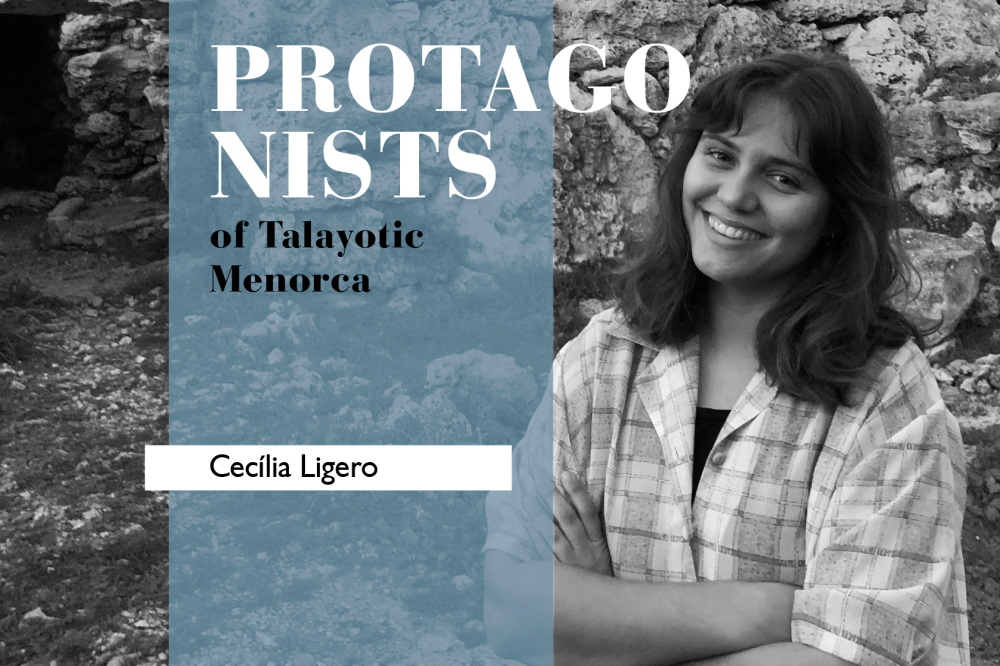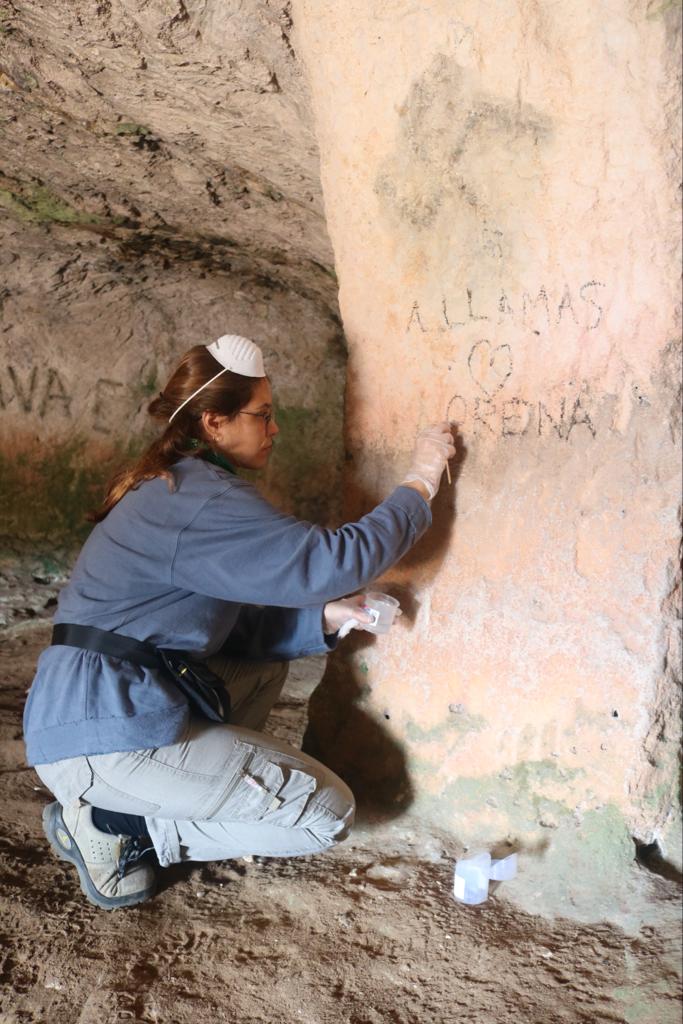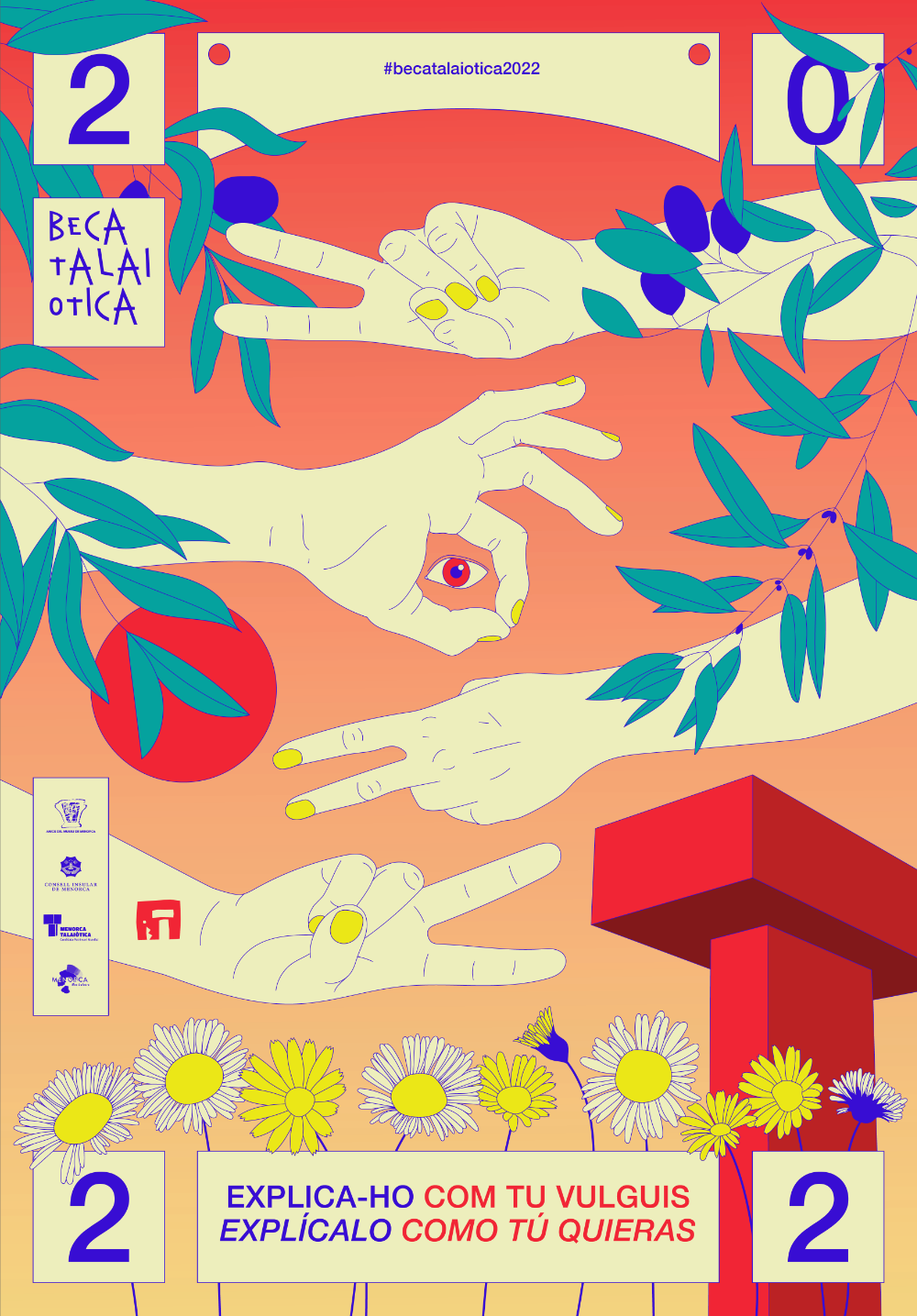 Cecília Ligero is a Menorcan restorer who has been president of the Amics del Museu de Menorca since 2016, and a member of their archaeological team since 2015, taking part in the excavation field seasons at Torre d'en Galmés and Torralba d'en Salort. Together with the archaeologist Carlos de Salort, she is the driving force behind the Becatalaiotica competition, a cultural project with the aim of promoting Talayotic Menorca's UNESCO World Heritage nomination among new audiences.
Cecília Ligero is a Menorcan restorer who has been president of the Amics del Museu de Menorca since 2016, and a member of their archaeological team since 2015, taking part in the excavation field seasons at Torre d'en Galmés and Torralba d'en Salort. Together with the archaeologist Carlos de Salort, she is the driving force behind the Becatalaiotica competition, a cultural project with the aim of promoting Talayotic Menorca's UNESCO World Heritage nomination among new audiences.
- What prompted you to focus on heritage conservation and restoration?
I came from the field of art and sculpture, and had always had a real interest in archaeology, history, art history… Studying conservation and restoration allowed me to tie together a lot of different elements that I found of interest at the time, and still do. And so without setting aside the manual or creative part, and while extending my knowledge in the scientific and historical sphere, I got involved in this training to learn to preserve heritage.
I have specialised in the architectural area, both in material interventions (ceramics, glass, metal, stone…), and in situ structural interventions. I also really enjoy the educational side, explaining heritage and the work involved in conserving or restoring sites. As protecting heritage as a universal task, it is important for everyone to contribute to its preservation. And the first step towards conservation is to gain awareness, which is acquired through knowledge. Cultural outreach gives people that awareness: when you are aware of something, you understand it, and when you understand it, you love, care, value…
- You have now been president of Amics del Museu de Menorca for six years. What role does the association have in connection with the UNESCO nomination?
The main tasks performed by Amics del Museu de Menorca are research and cultural outreach about the history, pre-history, art and heritage of Menorca. The goal is to help in studying and showcasing Menorcan culture. Much of the work that the association performs focuses on Talayotic culture, and so both directly and indirectly contributes to and supports the nomination.
The association is a platform of opportunities, or a means of undertaking projects which enrich the island at the cultural level, which in all cases involves public participation or proximity. It is a network of people, of interdisciplinary work and professionals from different spheres, collaboration, volunteering… in short, citizens who value, work and care for Menorca's heritage.
- And what activities connected with Talayotic Menorca do you have planned for the coming months and for 2023?
We have the sixth edition of Becatalaiotica in progress: a competition intended for young students, with the goal of staging various events or performances, making use of a forum connected with Talayotic Menorca. The competition is currently in its final phase, with five students coming to Menorca to stage their concept at an archaeological site, before an audience who will rate each of the proposals. The best proposal, in the eyes of the audience, will receive a €2,000 study grant.
The archaeological team of Amics del Museu continues its project researching Talayotic domestic spaces and those of the late Talayotic period at Torre d'en Galmés (with over twenty years of experience in the area). The fieldwork of this year's archaeological season has already ended, and is planned to resume next summer.
 This year, a new archaeological research project has also been launched at Torralba d'en Salort. In this case, in a post-mediaeval building, with the aim of excavating the structures and restoring all that we can to consolidate and adapt the site for visitors over the coming years. And aside from the work on land, we also work under the sea, continuing the study of the underwater archaeological chart of Menorca for a further year.
This year, a new archaeological research project has also been launched at Torralba d'en Salort. In this case, in a post-mediaeval building, with the aim of excavating the structures and restoring all that we can to consolidate and adapt the site for visitors over the coming years. And aside from the work on land, we also work under the sea, continuing the study of the underwater archaeological chart of Menorca for a further year.
Amics del Museu has contributed to the conceptualisation and coordination of visits within the Consell Insular and GOB Menorca "Som Talaiòtics?" programme in 2022. A programme which each month organises an outing on foot to various archaeological sites, accompanied by an archaeological explanation. This year we also included a tasting of some product of interest connected with the historical, artistic or culinary culture of Menorca, thereby supporting local and nearby produce, the initiatives of groups and companies from Menorca working in this area, etc.
Before the pandemic, volunteer days had been held over the course of five years to clean and clear scrub at Torre d'en Galmés. There have been requests to resume this project next year, following the hiatus. In this case it was the volunteers themselves who had taken part in the activities over so many years, who called for it to be resumed.
Meanwhile the association, specifically with Menorca Tir de Fona, has a historical re-enactment group of the Talayotic slingers: a re-enactment which has been staged on various occasions in Menorca and outside the island (such as to mark Tourism Day, or at the Roman historical re-enactment festival Tarraco Viva), which is to be repeated on future occasions. Aside from these projects, Amics del Museu de Menorca takes part each year in research or outreach seminars and conventions, organising or participating in guided tours, etc.
- You are one of a new batch of young professionals engaged in studying and conserving Menorca's historical heritage. What is it that most attracts you to the study of Talayotic culture?
I like to imagine what Menorca was like, or how it was in past eras. We have direct information about more recent periods, photographs, artworks, documents, oral sources… But for more ancient times we don't have that information, and instead have something else, something different: the megalithic remains that are so well preserved and integrated within Menorca's landscape. We have physical remains, which are furthermore of monumental scale. But however enormous they may be, that is not enough. We need more information, data allowing us to interpret and have a clear idea of what they were like and how they lived, these people that today we refer to as "Talayotic". Which is what makes the task of archaeological research and heritage education so important.
And each year there are more research teams making efforts to bring new data to light, giving us a better understanding and helping to shape the concepts we have. That's what it is all about. I think that one of the things that most attracts me is that however gradually, we are filling in the gaps and updating our perspective. It gives me satisfaction to know there is this concern, motivation and willingness to continue studying, and so to continue uncovering new information. The fact that there is in general that support, or to put it another way, that we feel there is increasing support on the part of public bodies. I am drawn to the opportunity to contribute to the task of continuing to put together the pieces of this jigsaw puzzle.
- As I mentioned earlier, you are one of the figures in charge of conservation and restoration tasks in the Amics archaeological projects at Torre d'en Galmés and Torralba. What is the current status of these two projects, and what is their importance for Talayotic Menorca?
Torre d’en Galmés, which is a truly exemplary Talayotic settlement, retains many structures which we link to the domestic sphere: houses, or circles. Amics del Museu has for a few years been excavating one of these buildings located at the foot of one of the talayots in the settlement, and there are still a few field seasons to go in order to complete the work. It won't be until we have completed these archaeological field seasons in situ that we will be able to try to restore the walls, consolidate them, or raise up displaced blocks, or any other intervention serving to adapt the space for its preservation, and to allow it to be safely visited.
So far a number of one-off consolidation interventions have been conducted on walls that were too unstable, to secure their integrity in time, as well as the personal safety of the team of archaeologists working beneath them, but we will need to wait for the forthcoming seasons before we can undertake any other intervention.
As for the laboratory work, during and after each intervention Francesc Isbert and myself, as co-directors of the conservation-restoration project, receive the materials and apply the necessary treatment so as to perform the least possible intervention (which is always reversible), guaranteeing their preventive conservation.
Meanwhile, in the intervention project on the post-mediaeval building at Torralba d'en Salort, in the sphere of conservation and restoration, so far a corner wall has been braced to secure its stability during the archaeological work. Over the coming field seasons, as work progresses on the excavations inside the building and around this wall, we will be able to do the necessary work to consolidate and stabilise it, without the need for bracing.
The expectation is that, once the archaeological work in situ is at a more advanced stage, walls can be raised, displaced elements replaced (provided that we have sufficient information as to their original placement), while also consolidating the structure to get it ready for visitors, and guaranteeing its preservation. Archaeological materials have been sent to us at the laboratory from this first field season (in particular ceramics), which we have worked on in accordance with the needs of each object or fragment. In both projects, conducting these archaeological and conservation-restoration tasks is vital in order to maintain the site and the studies conducted there, with a view to helping to better understand, preserve and showcase Talayotic Menorca.
- You are one of the figures behind Becatalaiotica. How did this cultural project arise?
Becatalaiotica arose out of Amics del Museu de Menorca's desire to undertake new (original) projects, and the need to address the lack of scheduled activities with reference to Talayotic Menorca that existed at the time to reach out to a younger population. With the support of the Consell Insular, we enabled a different way of visiting the sites from other perspectives, beyond the archaeological aspect; discovering heritage from an alternative point of view, and so giving an opportunity to a broader segment of the population, making it more inclusive. The idea being that heritage does not belong only to the cultural sphere, but is something where the whole population can find different approaches to enjoy it.
 Becatalaiotica served, and still serves, to showcase Talayotic Menorca within and beyond the island, as the competition is open to students from throughout Spain. It is one way of showing that young people can have the skills to create, implement and convey ideas. A platform to encourage young people to believe in and demonstrate their skills, learning to speak in public, coordinate tasks and people, or empathise with audiences of different ages.
Becatalaiotica served, and still serves, to showcase Talayotic Menorca within and beyond the island, as the competition is open to students from throughout Spain. It is one way of showing that young people can have the skills to create, implement and convey ideas. A platform to encourage young people to believe in and demonstrate their skills, learning to speak in public, coordinate tasks and people, or empathise with audiences of different ages.
Those of us who were behind the competition were fairly young when we created it (aged 25 and 21), and so I suppose that to some extent we could understand where most of the participants were coming from, an important factor in publicising or explaining the contest. There was a closeness between us, which made the whole thing approachable for the target audience, then and now.
- Do you think there is still to some extent a lack of understanding about the importance of Talayotic heritage among youngsters in Menorca? What do you think could be improved to arouse their interest?
Yes, I think there is something of a lack of understanding as to the importance of Talayotic heritage among young people in Menorca, but not only youngsters, across all sectors of the population. But I do nonetheless feel that we are doing more and more outreach work to educate people about the importance of heritage preservation. In the educational sphere, for example, to start with the basics: both at infant and primary schools, and also high schools, Talayotic Menorca increasingly has a place.
Nonetheless, we can't expect everyone to take an interest in culture, or in the case of Menorca, Talayotic culture and its legacy. People vary a great deal, in terms of their hobbies and interests, as well as their age. It is made easier by the fact that more and more initiatives are now taking place to showcase heritage and heritage protection. Reaching out to everyone isn't a straightforward task, and never will be, but we must aim to continue working along these lines.
To begin with, I don't think that you can get everyone to appreciate the value of this culture in the same way. And so it's important to work with different disciplines and organisations. The study, understanding and presentation of Talayotic culture covers many different spheres these days, and we have to take advantage of that. Not everyone enjoys guided tours, not everyone has an interest in cuisine, sport, art and sculpture, etc. But I do think that it enriches our approach if we can address Talayotic culture in any sphere, because that way more and more people have the chance to find a way of interacting with heritage. And however gradually, they are already appreciating it, and so directly or indirectly contributing to the preservation of these sites.
Right now, and this would undoubtedly have been unimaginable just a few years ago, there are a great many activities in different spheres, not exclusively heritage-based, that are in some way linked in with Talayotic culture: local Talayotic beer, pastisset pasty moulds in the form of sa Naveta des Tudons and the Talayotic baking competition, to give just a few examples. There are also sports races with routes that include heritage sites, musical concerts held at full moon alongside archaeological monuments, educational activities in the museum and out on the street, physical and/or visual art exhibitions or competitions addressing Talayotic Menorca, among others.
To encourage interest, I think that Talayotic Menorca, and hence all the people and organisations working on this, must be open to continued collaboration with such areas, as well as experimentation and exploration of other new fields.